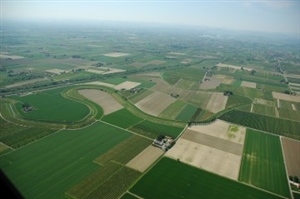A people deeply linked to his Land
 Life in the country and the culture of the land
Life in the country and the culture of the land: or, rather, living with memories, popular traditions, the local way of life. It was summed up by the Romagnol writer
Manara Valgimigli "…the real Romagnol soul is one who knows good land when he sees it, he picks up a clump of earth, crumbles it between his fingers and almost tastes it…"

And, if the art of creating food (the art of taking produce from the land, adding other ingredients, mixing them all creatively until you produce something which is completely different from the original elements…) is the oldest form of popular culture (par exellence oral),
Romagna is one of those places where the history of popular traditions goes hand in hand with the history of
culinary folklore.
Popular food in this part of
Romagna has always been closely linked to rituals (the seasons, “
eves”,
celebrations in the farmers’ calendar,
carnivals,
Lent), each with its own dishes, recipes or ingredients which it would be unthinkable to leave out. This is why celebrations and festivals revolve principally around food (they are dictated by the seasons and, consequently, by the freshness of the produce) and are still so alive and enjoyed even today in our towns and villages.

This area claims to have nurtured the origins of the best known cookery book in the world, “
Science in the kitchen and the art of good eating”, a clever work by the scholar and cook (albeit only for pleasure)
Pellegrino Artusi, who was born in
Forlimpopoli; Artusi’s style is brilliant and ironic (for instance, when talking about “
cappelletti in brodo”, he calls the capon the ... dumb animal who, for Christmas is ready to offer himself up as a martyr for men).
Pellegrino saw cooking as being
"…naughty, which often makes you despair, but also gives you pleasure …"
The undisputed king of local cuisine is still the “minestre” (word used in
Romagna to describe both pasta served in sauces and that served in stock). The pasta is made of wheat flour and fresh eggs, rolled out by hand by the women of the house: cappelletti (filled with ricotta, eggs, tender meat and nutmeg) are of gigantic proportions;
passatelli (mixture of eggs, cheese and breadcrumbs);
strozzapreti (made from the original “piadina” mixture),
tortelli filled with spinach and similar vegetables and
ricotta,
tagliatelle, perhaps served with rich, tasty sauces typically found in the inland hilly areas.

The Romans (and the Etruscans before them) already knew and appreciated the wine of this land: Pliny, for example, quotes
Sangiovese as a wine which ages well; Leonardo da Vinci, many centuries later, was so impressed by the care taken by the Romagnol wine producers when they hung up the grapes to dry in the winter, that he dedicated one of his drawings to this custom. When this wine was drunk at home, it was traditionally poured by the head of the family: as well as choosing the quality of wine to serve, he was also responsible for its preservation. Today, the five
typical Romagnol wines (
Albana,
Sangiovese,
Trebbiano,
Pagadebit,
Cagnina) are constantly improving their quality as they are produced in perfect enclaves on selected vines, most of which lie along the Forlì and Cesena Route.
Many local farm products are celebrated, starting with
olive oil at
Longiano,
Montiano and
Roncofreddo; cheeses from the area around
Sogliano (particularly “fossa” cheese which is left to mature in underground pits); woodland produce includes mushrooms from
Predappio and
Cusercoli and the valuable white truffle from Dovadola and the
Bidente Valley.
There are endless varieties of fruit and vegetables: maybe the cherries from
Civitella di Romagna and
Roncofreddo are the most esteemed. Two specialities which were, and still are, made expertly after the grape harvest from grape must, are
E’ Savor (an energy-giving jam made with various types of fruit) and la Saba, (sweet wine syrup) which becomes a kind of sorbet when you add fresh snow (fill your glass with snow before pouring in the syrup).

And lastly, popular Romagnol bread: “
piadina”, unmatched in taste, especially if eaten hot. Whilst bread was only baked once a week, at least during the winter (in the family’s oven, strictly respecting rituals which promised good results), "la
pida" filled the house with its unmistakable smell twice a day: just flour and water in hard times, and with salt and lard, perhaps even with some wild-growing herbs when times were better: it was religiously cooked on the “
teglia” – a plate made of rock and clay found upstream in the Uso River, at
Montetiffi at Sogliano.
In fact, nothing can beat the old-fashioned terracotta plate, because you need very little heat to warm it up and it then keeps in the moistness of the mixture, making the “
piadina” drier (today a young family has relaunched this product).
So, as you follow the itinerary of the
Route through the Hills of Forlì and Cesena, you can come across typical local produce (which will be described in greater detail on the next pages) or taste it as it is transformed into tasty dishes from the local area or further afield. And rest assured that the people who work along the Route will also take
Pellegrino Artusi’s advice: "…
the best sauce you can offer your guests…is a kind face and no nonsense friendliness!…"